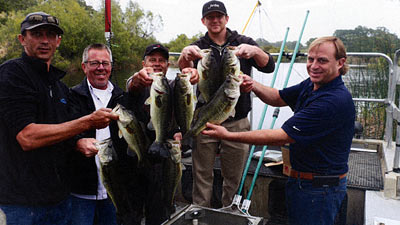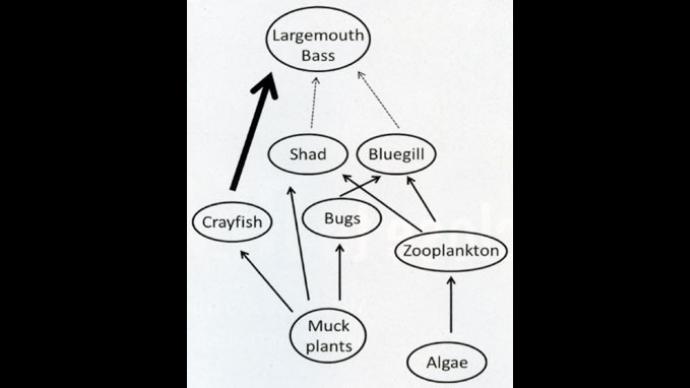
A recent study of interest to pond owners entitled Investigating Interactions between Channel Catfish and Other Sport Fishes in Small Impoundments by D. Michael Leonard, Dennis R. Devries and Russell A. Wright in North American Journal of Fisheries Management 30:732-741, 2010 by the American Fisheries Society contains some noteworthy information about interactions between channel catfish, largemouth bass and bluegill in ponds. Some of the findings are similar to points made by pond owners about those three species on the Pond Boss Forum. Other findings were quite different from those most would expect.
First, keep in mind the impoundments in this study are managed as public fishing lakes and are larger than most ponds, but are not big lakes. Here are some of the basic background considerations.
Catfishes are popular sport fishes throughout North America. Prior studies found more than 60% of surveyed agencies in the United States and Canada rated catfish as being moderately or highly important to anglers. In a survey of Alabama anglers, catfish were rated as one of the top four targeted species as well as the favorite fish to eat. As popularity of catfish among anglers has increased, so has a desire to stock catfish in small (i.e., less than 100-ha) impoundments. Many states offered specific recommendations for stocking channel catfish in small impoundments. Nearly all young-of-the- year channel catfish in small impoundments are susceptible to predation. Therefore, restocking is often necessary to maintain populations. Typically, channel catfish 200-mm total length (TL) or larger are stocked into systems with established populations of largemouth bass because fish of this size are large enough to avoid predation.
Channel catfish growth in small impoundments can be negatively related to their density and, therefore, stocking rates which yield in- traspecific competition are important to avoid. Both channel catfish and bluegills feed heavily on macroinvertebrates and at high abundances channel catfish can reduce macroinvertebrate abundance. Studies have suggested that if food resources become limiting, channel catfish may compete with bluegills.
As channel catfish grow, they become increasingly piscivorous (fish eating), leading to competition between channel catfish and largemouth bass, which typically are highly piscivorous in small impoundments. In addition, as many as 30-40% of channel catfish stocked in sportfishing ponds can become uncatchable by anglers, or "hook shy". As a result, a portion of the population may be large, piscivorous individuals that contribute little to the fishery and can have significant negative impacts on other fish populations.
Managers need to assess costs and benefits of stocking channel catfish into small impoundments if their population levels could result in consumptive demand negatively influencing bluegill populations. Further, there is a trend of declining fishing mortality of largemouth bass due to both reduced angler visits (U.S. Fish and Wildlife Service and U.S. Bureau of the Census 2006) and increased catch and release which is causing overpopulation in many small impoundments. Dense populations of largemouth bass combined with catfish overabundance in these systems may result in a demand for forage species that exceeds capacity.
These are the points most pond owners posting on the Pond Boss Forum would agree with and have discussed at length. The following are some eye openers. Keep in mind, however, that these are managed public fishing lakes and as such some of the problem factors noted above are managed out or greatly reduced.
Mean relative weights of bluegills, channel catfish and largemouth bass were not related. Channel catfish became increasingly piscivorous with size in three of the four lakes, but still primarily consumed insects throughout all sizes (from 85% to 99% insects). Of the 11 individual fish found in channel catfish diets, nine were either bluegills or unidentifiable Lepomis spp., and one was a largemouth bass. As bluegills increased in size, they consumed a smaller proportion of zooplankton (from 20% in bluegills, 75 mm to 6% in bluegills, 175 mm) and higher quantities of insects (from 73% in bluegills, 75 mm to 85% in bluegills, 175 mm). Largemouth bass across all sizes primarily consumed fish (from 54% to 67% fish), and their diets within size-groups were more variable among lakes than were bluegills or channel catfish.
Bluegill diets were highly similar among the four lakes. Largemouth bass diets also were highly similar among the four lakes. Channel catfish diet similarities were more variable between lakes and among lake comparisons. Largemouth bass and channel catfish diets were generally dissimilar within each lake across all seasons. Bluegill and channel catfish diets within lakes were moderately similar and showed no seasonal trends in similarity.
We found no evidence of intraspecific competition in channel catfish at densities currently maintained in study lakes. No evidence was found to suggest that channel catfish and bluegills were competing in focused sampling study lakes. The moderate overlap in diet between these species indicated that if prey resources were limiting, there was at least a possibility that these two species could compete.
No evidence was found to suggest that channel catfish and largemouth bass were competing in any but one of our study lakes (25% of the study). Current channel catfish stocking rates in most of these lakes appear to be maintaining densities below a level at which they would negatively affect bluegill and largemouth bass populations. If improved angler catch rates are desired, channel catfish stocking rates could be marginally increased to improve angling success without causing any significant negative effects on other sport fish.
There is much more data in this study to contemplate but my take is if you keep the channel catfish population low and their size small (under 5 lbs) you should be able to successfully include channel catfish as one of your pond species without negatively affecting your largemouth bass and bluegill populations. In doing so keep in mind that the biggest factor that limits the growth, condition and size of fish in most waters is insufficient food. So feed those bluegill and channel cats (bass also if you can) and enjoy eating those catfish before they get big.
Reprinted with permission from Pond Boss Magazine



